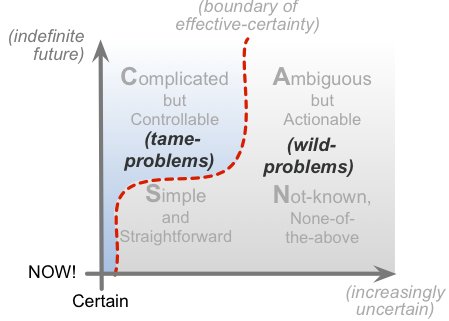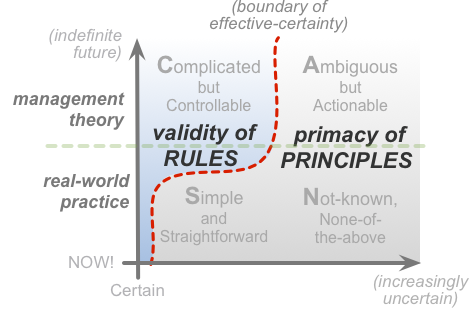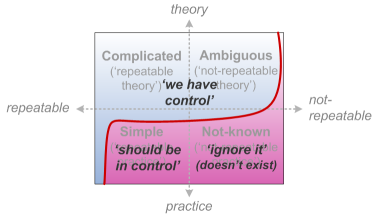The Demoralised Man
Right now there’s an interesting (to me, anyway!) discussion going on within the Enterprise Architecture Network community on LinkedIn, on the role of ethics in EA, and its relationship with EA as a profession. I’ve added a few quick comments there, but to my mind it needs assessment in proper depth – hence a longer-form post here.
To me, one of the defining characteristics of a shared-enterprise or, especially, a profession, is commitment to an agreed ‘vision‘ or shared-promise, and its concomitant values. Those values in turn are often expressed and codified in a formal statement about ethics – about expectations of appropriate behaviour in context of that enterprise-vision – and made actionable through explicit principles for decision-making within real-time action.
The situation we have right now in enterprise-architecture is that there are no real standards for the discipline as a profession, and no clear ethics either. There’s no clear definition, or even some kind of generally-agreed understanding, of what enterprise-architecture is, or what an enterprise-architect does, or what personal responsibilities and commitments declaring oneself as ‘an enterprise-architect’ would imply.
If we look at recruitment-ads, it seems EA can be high-level strategy or low-level code and almost anything in between. Some place it solely within IT; increasingly we’re seeing more ads that place it in other domains entirely. Either way, there’s no clarity, no consistency, no sense, no nothing.
There are a fair number of would-be professional-bodies, each claiming to be the sole representative of the entire profession. But in almost all cases there’s a mess of spurious special-pleading going on, applying arbitrary constraints to promote their own special-interests, often with certification-schemes that sometimes seem little better than outright scams.
In effect, anyone can declare that they are ‘an enterprise-architect’, and there’s nothing to stop them from doing so. And also no clear indication of the implications and responsibilities of doing so. Tricky…
Yet that applies to me too, of course: I often describe myself as an ‘enterprise-architect’ of sorts, both on this weblog and elsewhere. I’m ‘TOGAF Certified’, as it happens – but that’s all but meaningless in practice, and it’s never been of any real use to me anyway. The reality is that my claim to be an ‘enterprise-architect’ is that I say I am – nothing much more than that.
(A key point, though, is that most of my peers would openly recognise me as ‘an enterprise-architect’. And unlike a lot of self-styled ‘enterprise-architects’, I can also validate my claim with a large body of work on the architectures of enterprises – though much of it covers a much broader scope for EA than allowed for by any of the current would-professional-bodies for the discipline.)
But perhaps the core here is that my claim to be a professional rests not just on what I know, and what I can do, but even more on the ethics, values and principles by which I work and live. In the absence of a valid professional-body, they’re largely self-chosen and self-policed, but they still definitely do guide my choices and actions. For example:
- I am always responsible to all of the stakeholders in a shared-enterprise – not solely the organisation that pays me.
- I will not work for or with organisations or industries that act in a clearly unethical manner. (Yes, most of the so-called ‘finance-industry’, I’m looking at you…)
- If I consider myself not-competent to do something, I will always say so.
- If you don’t value my work, I won’t take your money.
…and so on. The point here is that, if they’re to have any meaning at all, then ethics, values and principles must lead to real consequences – especially for professionals. Here’s a real example (though not one of my own):
— A few decades back I was at an engineering research-lab, on contract as a business-analyst and technical writer. The project was about a series of tests on a very large, very expensive and probably-irreplaceable test-article. Because of this, the project-manager declared that protection of the test-article was the single highest priority for the project. One of the senior engineers quietly asked if he insisted on this: he said ‘Yes’, firmly, loudly. Again gently, the engineer pointed out that according to the ethics-statement for professional-engineers, the highest priority of any project must always be the safety of people, before things. If the manager did continue to insist that the test-article had highest-priority, then every engineer in the lab would have to resign immediately – because if they didn’t, they would be permanently struck off the professional register, and lose their licence to practice as engineers. The manager blustered for a while, but when senior-management got involved and recognised the real consequences at risk, it soon became clear this was not a battle he was going to win. And he didn’t.
But what’s the opposite? What does it look like when a would-be profession doesn’t have a meaningful code of ethics? – or, if there is one, when it’s generally ignored? That’s where this gets messy…
If EA is a self-styled ‘profession’ that operates across all business-domains, yet without a clear professional-body or clear code of ethics, then probably its closest parallel is the self-styled ‘profession’ of management. People assert their claim to be ‘managers’ because they say they are. There’s no clear professional-body, no exam, no profession-specific regulation, no clear-cut professional qualification: the nearest to the latter is the MBA, but the curriculum and standards vary wildly, and in any case it is, literally, a ‘Master of Business Administration‘ – in other words, a glorified clerk. In essence, people can claim to be ‘managers’ because they say they are – nothing much more than that.
If there’s one cross-domain ‘profession’ that’s become notorious for too-routine absence of apparent ethics, it would have to be management. And for a literally lethal example of what happens when management goes wrong, I keep coming back to that quote about management in the UK NHS [National Health Service) in a BMJ report by Heather Wood:
The horrors at Stafford Hospital were failures of clinical care – but these were the symptoms, albeit deeply distressing, of a serious underlying illness. And that deep rooted pathology is the stranglehold that managers, many apparently devoid of an ethical code and certainly without a regulatory body, have on the NHS.
Yet elsewhere in the article, we start to get a sense of the deeper cause:
… Where some poor care may, arguably, stem from a fault line in the training of nurses, we found evidence that the poor care and failure to control infection were related to the determination of managers to drive through financial restraint and achievement of targets.
In effect, it’s not so much that individual managers themselves have lost any adequate sense of ethics, but that the overall would-be ‘profession’ itself has as yet no real concept of ethics, or what it’s for, or why. In an all-too-literal sense, it’s missing the point about values – that values must always have primacy above arbitrary ‘rules’. To quote Heather Wood again, about the healthcare context:
The NHS, though it needs to run efficiently, is not a business. It is about diagnosing, treating and caring for patients in the best way. All its other functions should be subservient to that.
By definition, values and ethics must apply everywhere in an enterprise – not least because they define what the overall shared-enterprise is. Managers, however, live in a world of rules – usually made-up rules such as KPIs and targets. In practice, though, that kind of worldview – often described as Taylorism, ‘scientific-management’ or the linear-paradigm – only makes sense in that subset of the real-world where such rules can make sense. In terms of context-space mapping with the SCAN framework, that’s the subset of the real-world that’s to the left of the ‘boundary of effective-certainty’:
Which, again, is only a subset of the context – not the whole. And to make things worse, rules often appear to work far better in theory than they do in real-world practice – such as we see also with the crucial distinctions between tame-problems and wild-problems (or ‘wicked-problems‘):
Which means that there’s a much larger part of the real-world scope where the managers’ made-up rules won’t and can’t make sense, and where ethics and values must always have explicit primacy over those rules:
Where this point is properly understood, and rule-oriented management in effect becomes ‘just another service‘ that exists to support rather than ‘control’, the context can work well for everyone. (In his book Creativity, Inc., Ed Catmull describes how and why this approach succeeded so well in the earlier days at Pixar.) To use Heather Wood’s term above, management provides a genuine service to the enterprise only when it acknowledges itself as subservient to the needs of the shared-enterprise as a whole.
Unfortunately, under the Taylorist paradigm, managers often won’t see themselves as subservient to anything – instead, they tend to regard that everything else is and must be subservient to management. (It’s notable, for example, that whilst managers may often rage about ‘insubordination’, few seem to be aware of its symmetric-opposite of ‘insuperordination‘…) One result is that they’ll often fail to see, or accept, that their rules won’t work – and instead insist that it is not the rules, but the real-world, that is ‘wrong’:
When that happens, ethics are literally overruled: arbitrary rules are assigned a higher priority than deeper principles. For example, to quote Heather Wood once more:
… All the failings at Mid Staffs derived from the handing of control of decisions on priorities from the clinical professions to managers who were ultimately expected to follow the orders of senior managers.
Which, in turn, leads to what we might (with apologies to Alfred Bester) describe as The Demoralised Man. The point is that there are two distinct meanings of ‘demoralised’ here:
- de-moral-ised – morals and ethics overruled, ignored, or non-existent in the first place
- de-morale-ised – morale and commitment destroyed
Almost invariably, the first – the disconnect from the guiding morals and ethics for the context – creates the second – deep demoralisation amongst other players in that context.
And when that happens, the whole enterprise becomes set on a downward vicious-spiral:
- management ‘controls’ lead to demoralisation
- demoralisation leads to loss of engagement in the work
- loss of engagement leads to falling productivity and quality of service
- falling productivity and quality give rise to increasing inefficiency, ineffectiveness, waste and cost
- management attempts to rein in the costs and bring back productivity and quality by applying stronger ‘controls’
In the NHS context, it’s now blatant to all but a few politicians and the more ‘power’-obsessed managers that the core cause of rising overload and falling quality has been the ever-increasing managerialisation of the overall service over the past few decades. Yet courtesy of ‘policy-based evidence‘ and related delusions, the only ‘solution’ currently on offer is yet more managerialisation and yet more ‘targets’ and ‘controls’ – all of which, by definition now, is capable only of making things even worse than they already are. Not a happy time for anyone – and most definitely Not A Good Idea…
There are feasible ways out of this kind of mess. In each case, the core requirement is a clear sense of enterprise-purpose, and clear values and ethics that can guide appropriate decision-making in the midst of ambiguity, uncertainty and the unknown – because rules alone are not enough.
Which brings us back to enterprise-architecture and enterprise-architects. As it happens, we do have the skills and, I would argue, the responsibility to define and design appropriate structures that support more viable management-models for the enterprise. That’s a key point in itself.
Yet the real core is that we need to learn the lessons from the mistakes of those misframed management-models. Just as with the managers, ethics are essential in every aspect of our work: we will not be able to make appropriate decisions without them. Like the managers, we don’t yet have a professional-body to guide us and, if necessary, to apply sanctions us if we fail in our ethical responsibilities – but again as with the managers, that’s no excuse to ignore our ethical responsibilities. If there’s no-one to set ethics for us, and perhaps even (or especially?) if there is, then we need to set those ethics and values for ourselves, as our responsibility to ourselves and to others – and then live by those ethics, in every moment and in every decision of every day.
(As best we can, anyway – because unlike rules, there’s no way we could always get it ‘right’. Just better, always better, as best we can.)
A profession is only a profession because of its shared ethics. A professional is only a professional because of their commitment to those ethics.
Enterprise-architecture will shift from a disparate set of disciplines, to a true and viable profession, when it, and everyone in it, commits to real ethics that respect every stakeholder in the respective enterprise.
And we don’t need to wait for a professional-body to emerge, to impose an external ethics upon us. Instead, the onus is on us – on each of us, personally, right here, right now, every day, everywhere. That’s all it takes.
In which case, what are your ethics and values? How do you live those values, in your work as an enterprise-architect and elsewhere? What ethics-challenges do you face? And how – if at all – do you resolve them? Over to you for comment on that, perhaps?




Very nice piece. I would watch out for the use of the word ‘principles’ in this context. You mean it as ethics here, but many enterprise architects (and management, in the EA context) see them as just a different set of *rules*.
Maybe we should use ‘enterprise architecture ethics (principles)’ instead of ‘enterprise architecture rules (principles)’
Thanks, Gerben. My worry here – from what you’ve said – is that if anyone thinks that a principle is just another kind of rule, they’re completely missing the point about the purpose of principles. Not A Good Idea…?
Both rules and principles support decision-making, yet – to use SCAN terminology – they apply primarily apply on opposite sides of the ‘boundary of effective certainty’, the order/unorder boundary:
— rules provide prepackaged ‘true/false’ (i.e. ‘truth’-oriented) decisions in contexts of apparent/perceived order and certainty
— principles provide advisory guidance for ‘better/worse’ (i.e. value-oriented) decisions in contexts of apparent/perceived unorder and uncertainty
Yes, the two types do blur, but the applicability is the key: context-first rather than content-first. For example, “Buy before Build” is – or should be! – more a principle than a rule: we use that principle to help us decide what to do, but it’s always clear that there is a choice, dependent on the uncertainties inherent in that context. If we apply the principle as if it’s a rule (true/false), we’re likely in some cases to end up with solutions (lesser value) than if we’d gone against the rule.
In a sense this is also where ethics applies: we’re made aware that despite all of the rules, there are always some cases where going against the rule is the right thing to do. For example, in general it’s very wrong to hit someone – especially hitting them hard enough to knock them out. But if they’re panicking in a burning building, or in a tidal rip, you might well have to do just that in order to save their life, or protect them from other more serious harm. The key to all of this is that ultimately it is always a choice, and always our personal responsibility as a choice. A clear sense of ethics, and its concomitant principles, is what helps to guide us in each of the right-at-the-moment-of-action choices.
And yeah, me being me, it turns out that I had indeed written another blog-post on this, a few years back: ‘Principles and checklists‘. Hope it’s useful, anyway? – and thanks again.